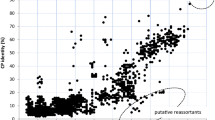Abstract
Phylogenetic analysis of viral and cellular thymidine and thymidylate kinases was performed using computer-assisted methods. Multiple alignments and tentative phylogenetic trees were generated for the two families of these enzymes, which include a) thymidine kinases (TK) of mammals, poxviruses, African swine fever virus,E. coli, and bacteriophage T4; and b) thymidylate kinases (ThyK) of yeast and poxviruses and distantly related herpesvirus proteins with both enzymatic activities. Analysis of the alignment of the TKs of the first family highlighted three strongly conserved segments. Two of these corresponded to the A and B motifs of the purine NTP-binding pattern. The third, C-terminal segment, showing the highest conservation, encompassed a modified Zn finger motif. It is speculated that this motif might be involved in TK oligomerization. Phylogenetic trees constructed by three different methods suggested that cellular TK genes could be captured independently by T4 bacteriophage, African swine fever virus, fowlpox virus, and the other poxviruses. The observed tree topologies appear to contradict the popular virus-host coevolution schemes and to imply that different subdivisions of poxviruses diverged at earlier stages of evolution than their hosts did. It was shown that deoxynucleoside monophosphate kinase of bacteriophage T4 is related to the ThyK family. Phylogenetic analysis suggested that ThyK genes probably have been acquired independently by phage T4, poxviruses, and herpesviruses.
Similar content being viewed by others
References
Kit S., Mol Cell Biochem11, 161–182, 1976.
Kit S., Microbiol Sci2, 369–375, 1985.
Gentry G.A., Rana S., Hutchinson M., and Starr P., Intervirology29, 277–280, 1988.
Gorbalenya A.E. and Koonin E.V., Nucleic Acids Res17, 8413–8440, 1989.
Boyle D.B., Coupar B.E.H., Gibbs A.J., Seigman L.J., and Both G.W., Virology156, 335–365, 1987.
Blasco R, Lopez-Otin C., Munoz M., Bockamp E.-O., Simon-Mateo C., and Vinuela E., Virology178, 301–304, 1990.
Black M.E. and Hruby D.E., Molec Microbiol5, 373–379, 1991.
Robertson G.R. and Whalley J.M., Nucleic Acids Res16, 11303–11317, 1988.
Smith G.L., de Carlos A., and Chan Y.S., Nucleic Acids Res17, 7581–7590, 1989.
Goebel S.J., Johnson G.P., Percus M.E., Davis S.W., Winslow J.P., and Paoletti E., Virology179, 247–266, 1990.
Gibbs A., J Cell SciSuppl 7, 319–337, 1987.
Schnitzlein W.M. and Tripathy D.N., Virology181, 727–732, 1991.
Leontvich A.M., Gorbalenya A.E., and Brodsky L.I., Biopolimery i Kletka6(6), 12–19, 1990 (in Russian).
Gorbalenya A.E., Blinov V.M., Donchenko A.P., and Koonin E.V., J Mol Evol28, 256–268, 1989.
Sneath P. and Sokal R.,Principles of Numerical Taxonomy. San Francisco, 1973.
Felsenstein J.,Phylip 3.2 Manual. Univ. of California, Herbarium, Berkeley, CA, 1989.
Chumakov K.M. and Yushmanov S.Yu., Molek Genetika3, 3–9, 1988 (in Russian).
Yushmanov S.Yu. and Chumakov K.M., Molek Genetika3, 10–15, 1988 (in Russian).
Walker J.E., Saraste M., Runswick M.J., and Gay N.J., EMBO J2, 945–951, 1982.
Black M.E. and Hruby D.E., J Biol Chem265, 17584–17592, 1990.
Gibson T.J., Postma J.P.M., Brown R.S., and Argos P., Protein Eng2, 209–218, 1988.
Frankel A.D., Bredt D.S., and Pabo C.O., Science332, 70–73, 1988.
Black M.E. and Hruby D.E., Biochem Biophys Res Commun169, 1080–1086, 1990.
Drillien R., Spehner D., Villeval D., and Lecocq J.P., Virology160, 203–209, 1987.
Griffin A.M. and Boursnell M.E.G., J Gen Virol71, 841–850, 1990.
Traut T.W., CRC Crit Rev Biochem23, 121–169, 1988.
Broida J. and Abelson J., J Mol Biol185, 545–563, 1985.
Smith, R.F. and Smith, T.F., Proc Natl Acad Sci USA87, 118–122, 1990.
Feng D.F., Johnson M.S., and Doolittle R.F., J Mol Evol21, 112–115, 1985.
Author information
Authors and Affiliations
Rights and permissions
About this article
Cite this article
Koonin, E.V., Senkevich, T.G. Evolution of thymidine and thymidylate kinases: The possibility of independent capture of TK genes by different groups of viruses. Virus Genes 6, 187–196 (1992). https://doi.org/10.1007/BF01703067
Received:
Accepted:
Issue Date:
DOI: https://doi.org/10.1007/BF01703067




